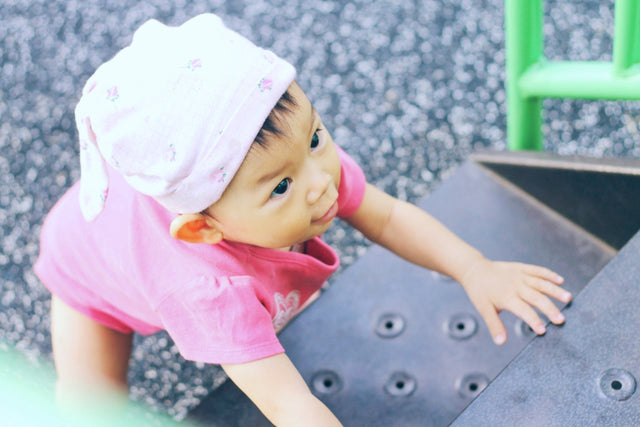When Will Your Baby Start to Climb?

In terms of big muscle accomplishments, crawling, walking, and running are the toddler milestones we are all familiar with, but what about climbing? It may seem like watching your tot scale pieces of furniture serves little more purpose than increasing your heart rate. But, studies show that climbing helps young kids develop spatial awareness skills, improve balance and coordination, and it may even help with cognitive development. After all, they need to do a lot of problem solving to figure out how to climb on top of the kitchen table!
When do babies start climbing?
Climbing is part of the natural progression ever since your baby learned how to pull themselves up. It’s no surprise that once they can defy gravity and stand without holding on, they want to do it more and more. Think of it from your child’s perspective, they can now: see the world from a totally new POV, they have the fun of balancing that big head in the air (kind of like the first time you rode a bicycle), and they are ecstatic to be able to do what everyone else around them have been doing for their entire lives!
After standing, comes the heady joy of walking and running, and then the thrill of climbing. (Actually, the first climbing starts shortly after they begin to crawl…the challenge of the stairs!) It will take another year before your wee one can pull their whole body onto a tall bed and climbing on low tables, sofas, and trying to scale the dresser is not far after that. (Climbing playground slides is still several years ahead…and then come trees!)
How do I keep my climbing baby safe?
Be consistent with the boundaries of what is and isn’t allowed. Put up gates that keep your wiggle worm out of danger locations in your home. Be sure to remove cords that might cause strangulation or that they might pull on—as they try to climb—and yank down a lamp or TV! Also make sure any large pieces of furniture are securely anchored to prevent injury from furniture falling over. Make sure the crib mattress in their crib is on the lowest level. And if they still try to get out, it’s time to make the switch to a “big kid bed.”
How can I help my baby learn to climb?
The best way to help your baby learn to climb is by presenting safe opportunities. As nerve-wracking as watching your toddler climb may feel to you, there are benefits to helping them practice this skill in a safe environment.
How do I encourage my baby to climb?
When you notice they are interested in climbing—like if they are trying to hike their leg up onto the couch or take on a bigger challenge at the playground—your focus should be on creating safe opportunities to practice their skills. This could be by participating in an age-appropriate gymnastics class or pulling cushions off the sofa and for your child to practice climbing in the living room.
And, when they get to the top, you can nudge them— just a little—so that they have to put out a hand to secure themselves or rebalance. The goal if that is to teach your child what it feels like to start to lose balance, so they can develop the skill to rebalance and not fall. As with anything else, encouragement from you goes a long way toward boosting your child’s morale.
Should I be worried if my baby isn’t climbing?
Ability isn’t the only factor when it comes to your child learning to climb. Their personality and temperament can also affect whether or not they are climbing! Although climbing the stairs is a matter of practicality, your toddler doesn’t have to climb to the top of the playground by themselves if they don’t want to.
Shy tots may be slow and cautious in climbing and adventuresome ones are constantly pushing the limits. You may feel like you live 100% of your life at the Olympics: stronger, higher, faster! As always, if you have any concerns, take them up with your child’s medical provider.